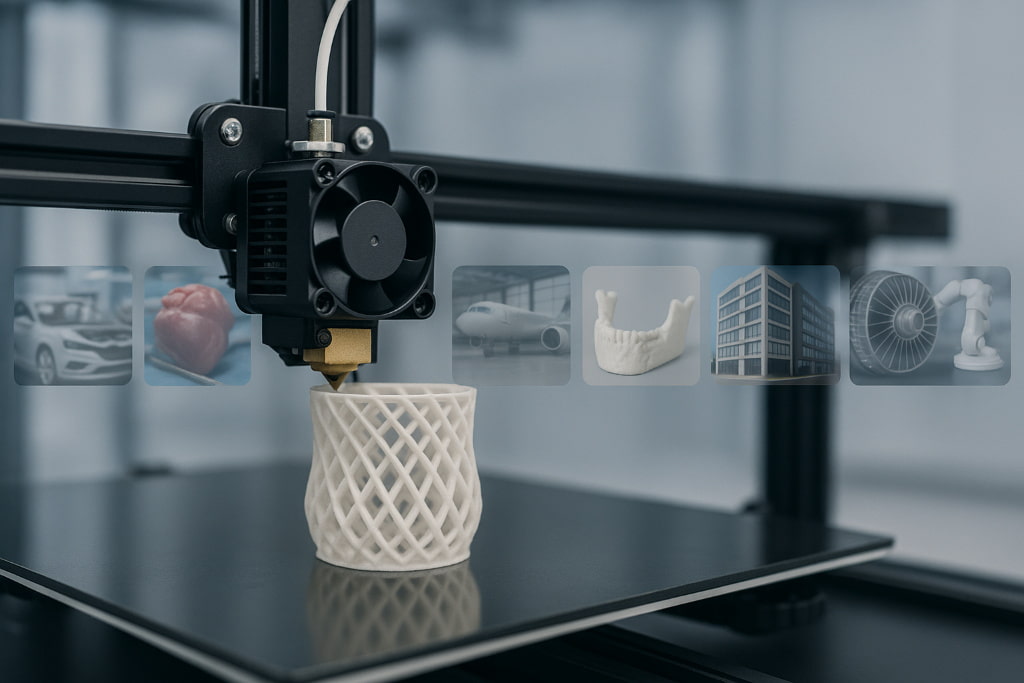
- +91 8055996347
- info@3dreality.in
- Chapru nagar square, CA road, Nagpur, Maharashtra-440008

Imagine a world where shoes are custom-built for your feet in hours, homes rise from printers instead of bricks, and human organs are being “grown” rather than donated.
Sounds unbelievable?
Welcome to the world of 3D printing—no longer just a tech buzzword, but a real-world game-changer that’s revolutionizing the way entire industries function.
Let’s dive into seven major industries that are being completely reimagined, thanks to this mind-bending technology.
What if a printer could save your life?
That’s exactly what’s happening in the medical world. 3D printing has enabled doctors to create patient-specific implants, prosthetics, and even surgical models for complex procedures. But the real jaw-dropper? Bioprinting.
Researchers are now using living cells to print human tissues—like skin, cartilage, and in experimental stages, even organs. While we’re not quite printing beating hearts yet, the future looks incredibly promising.
Imagine: A future where organ transplant waiting lists are a thing of the past. That’s the magic 3D printing is working behind hospital doors.
In space, every gram matters.
That’s why companies like NASA, Boeing, and SpaceX are turning to 3D printing to create ultra-lightweight, high-strength components for spacecraft and aircraft. Traditional manufacturing often requires multiple parts to be assembled together—but 3D printing creates them in one go, saving time, weight, and potential failure points.
And here’s the twist: NASA has even experimented with 3D printing in zero gravity—testing how astronauts might one day print tools and parts directly in space.
From rocket engines to satellites, the sky is not the limit—it’s just the beginning.
The car of the future might just roll off a printer.
Major automotive brands like Ford, BMW, and Bugatti are integrating 3D printing into their design and production workflows. It allows them to build prototypes in hours, test faster, and even produce custom or rare parts for high-end vehicles.
But it’s not just the big players. Car enthusiasts can now print customized interior pieces or vintage car parts that are impossible to find.
Soon, your mechanic might swap your broken part not with a spare—but with something printed on demand.
Think about this: a full-sized home printed in 48 hours. It’s not sci-fi—it’s happening.
Construction companies worldwide are embracing large-scale 3D printing to build houses, office structures, and even bridges. The materials? Special concrete mixes or earth-based compounds that are layered automatically.
This innovation significantly reduces waste, labor costs, and time. And the designs? Anything but boring—curves, domes, and wild geometry are now feasible at no extra cost.
3D Printing in Real Estate is a booming niche, and platforms like 3dreality.in are enabling customized, on-demand architectural models and even structural components that bring futuristic homes closer to reality.
The fashion world thrives on innovation—and 3D printing has become the new runway darling.
Designers are now creating stunning, intricate pieces—everything from avant-garde dresses to custom-fit shoes and jewelry—all printed layer by layer. What used to take weeks of craftsmanship now takes just hours.
It’s not just about art either. Sustainability is a big bonus. With zero-waste production and the ability to recycle materials, fashion can finally shift toward greener processes.
Who says you can’t download your wardrobe?
Imagine giving students a chance to hold complex math models or historical artifacts—custom made just for them.
Schools and universities are adopting 3D printing as a hands-on learning tool. From biology models to working mechanical systems, students are engaging with subjects like never before.
This tactile learning helps students understand abstract concepts with real-world application. Plus, future engineers, designers, and medical students get early exposure to one of the most powerful tools of tomorrow.
In essence, 3D printing is not just changing what students learn—but how they learn.
Yes, you read that right. Food.
Chefs and researchers are now exploring how 3D printing can craft edible masterpieces. Using edible pastes like chocolate, dough, and even plant-based proteins, machines are creating intricate designs and custom shapes you could never make by hand.
In hospitals, food printing is helping patients with swallowing difficulties get nutritious meals in safe, customized forms.
Imagine ordering a personalized cake online—and watching it printed in your kitchen. Sounds deliciously futuristic, right?
We often think of revolutions as loud, chaotic, and disruptive. But this one hums quietly in labs, factories, and offices. 3D printing isn’t just changing how we make things—it’s changing what’s possible.
From saving lives to saving time, from printing rocket parts to your dinner—this technology is quietly reshaping our world, one layer at a time.
And if you’re curious about how you can bring this tech into your world, keep an eye on platforms like 3dreality.in, where imagination meets innovation.
Because the future isn’t just being built—it’s being printed.